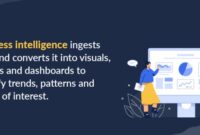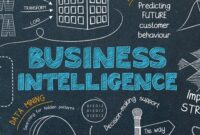What is business intelligence bi – What is business intelligence (BI)? It’s the key to unlocking the power of data, transforming raw information into actionable insights that drive informed decision-making and fuel business growth. BI empowers organizations to analyze data from multiple sources, identify trends, predict outcomes, and make strategic choices with confidence.
In today’s data-driven world, BI is not just a buzzword; it’s a necessity for businesses of all sizes. With BI, organizations can gain a competitive edge, optimize operations, and maximize profitability.
1. Introduction
Business intelligence (BI) refers to the technologies, applications, and practices for collecting, integrating, analyzing, and presenting business information to support decision-making.
Key components of BI include:
- Data collection
- Data integration
- Data analysis
- Data visualization
- Data mining
Benefits of using BI in businesses include:
- Improved decision-making
- Increased operational efficiency
- Enhanced customer service
- Reduced costs
- Increased revenue
2. Types of Business Intelligence
Descriptive BI
Descriptive BI provides insights into past and current business performance. It answers questions such as “What happened?” and “What is happening?”
Diagnostic BI
Diagnostic BI helps identify the root causes of business problems. It answers questions such as “Why did something happen?”
Predictive BI
Predictive BI uses statistical models to forecast future trends and outcomes. It answers questions such as “What is likely to happen?”
Business intelligence (BI) encompasses the strategies and technologies used to transform raw data into actionable insights. A key trend in BI is self-service business intelligence, which empowers business users with tools and technologies to analyze data and generate insights without relying on IT support.
Self service business intelligence enables faster decision-making, increased agility, and improved data literacy throughout the organization. Ultimately, BI provides businesses with a comprehensive understanding of their operations, enabling them to make informed decisions and drive growth.
Prescriptive BI
Prescriptive BI recommends actions to improve business performance. It answers questions such as “What should we do?”
3. Data Sources for BI
Internal Data
Internal data is data generated within an organization, such as sales data, customer data, and financial data.
External Data
External data is data collected from outside an organization, such as market research data, industry data, and economic data.
Big Data
Big data refers to large, complex, and rapidly growing data sets that are difficult to process using traditional data processing techniques.
4. BI Tools and Technologies: What Is Business Intelligence Bi
Data Visualization Tools
Data visualization tools help users visualize data in charts, graphs, and other visual formats.
Data Mining Tools
Data mining tools help users identify patterns and trends in data.
Reporting Tools
Reporting tools help users create and distribute reports that summarize and present business data.
5. BI Applications in Different Industries
Healthcare, What is business intelligence bi
BI is used in healthcare to improve patient care, reduce costs, and enhance operational efficiency.
Business intelligence (BI) empowers businesses to make informed decisions by transforming raw data into actionable insights. It encompasses various techniques, including data mining, statistical analysis, and visualization.
To gain a comprehensive understanding of BI, it’s essential to explore the managerial perspective, which delves into the strategic implications of BI and its integration with analytics and data science.
For an in-depth analysis, refer to business intelligence analytics and data science a managerial perspective for insights on how BI can drive business success.
Retail
BI is used in retail to optimize inventory management, improve customer service, and increase sales.
Manufacturing
BI is used in manufacturing to improve production efficiency, reduce costs, and enhance quality control.
Finance
BI is used in finance to manage risk, improve profitability, and enhance compliance.
6. Best Practices for Implementing BI
Data Governance
Data governance ensures that data is accurate, consistent, and accessible.
Data Quality

Data quality refers to the accuracy, completeness, and consistency of data.
Business intelligence (BI) involves gathering, storing, and analyzing data to gain insights and make informed decisions. It empowers businesses to understand their performance, identify trends, and anticipate future outcomes.
When preparing for a BI interview, it’s crucial to review common business intelligence interview questions.
These questions assess your understanding of BI tools, data analysis techniques, and your ability to apply BI principles to solve real-world business problems.
By understanding the fundamentals of BI and preparing for interview questions, you can showcase your expertise and increase your chances of success in the field.
User Adoption
User adoption is essential for the successful implementation of BI.
7. Future Trends in BI
Artificial Intelligence (AI)

AI is being used to automate BI tasks and improve the accuracy of BI insights.
Machine Learning (ML)
ML is being used to create predictive models and identify patterns in data.
Closing Summary
In essence, BI is the compass that guides businesses through the ever-changing landscape of data. By embracing BI, organizations can harness the power of information, make smarter decisions, and achieve lasting success.
FAQ Resource
What are the key components of BI?
Data sources, data analysis tools, reporting and visualization tools, and user interface.
What are the benefits of using BI?
Improved decision-making, increased efficiency, reduced costs, enhanced customer experience, and competitive advantage.
What are the different types of BI?
Descriptive BI (historical data), diagnostic BI (root cause analysis), predictive BI (future trends), and prescriptive BI (recommendations).




